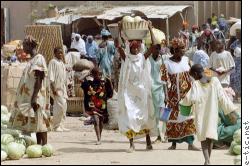Regions
Our regions of work

Within this context, the E-TIC program has specifically been active in the six locations, in which farming herding and fishing are of major importance, in addition to the two capitals, major hubs of economic activity:
Mali
- Tombouctou: rice and wheat, livestock, fishing
- Ségou: ceral, rice, all kinds of millet, livestock, fishing
- Sikasso: yams, mango, weight of soil, fruit in general farming, also cotton, but industrial
- Bamako: headquarters of many organizations
In the Tombouctou Region, rice and wheat are the main crops cultivated and stock-breeding represents an important activity, with almost 60% of the population involved in it. The types of stock-breeding practiced are transhumant, nomadic and sedentary stock-breeding. Animals are sold at the Timbuktu market, but also in the large animal markets held in Mauritania and Algeria. Therefore, for stockbreeders who wish to sell their animals, it would be useful to be able to obtain information in advance regarding the prices so as to receive a better price at the outset. Especially as many of the stockbreeders are illiterate, the most useful means of communication for them, in this sense, would be the community radio. There is a community radio station, “Radio Boctou” as well as a regional radio and national television network. Mobile phones are also widely used and there are several points of Internet access in Timbuktu. The languages spoken in this region of Mali are Bambara, Songhaï and Tamasheq.
In the Ségou Region, the population is largely made up of nomads and semi-indigenous and indigenous peoples. Ségou was found to produce the largest proportion of foodstuffs in Mali. Cereals, including millet and wheat, vegetables and tubers (potatoes, sweet potatoes) are cultivated here. It was found that farmers, stockbreeders and fishermen are all in need of training in new techniques and methods in order to increase the profitability of their produce. As far as communication is concerned, there are a number of Internet cafés in the region. The main languages spoken in this region are Bambara or Djoula.
Significant agricultural activity takes place in the Sikasso region. Sikasso has cultivated lands and is the scene of significant agricultural activity. Among the cultivated products, one finds in particular fruits and vegetables, which give self-sufficiency to the city. It acts as a crossroads between the coastal countries (Togo, Benin, Ghana, Côte d’Ivoire) and the coastlines of Mali and Burkina Faso.
Senegal
- Guédé-Chantier: rice, greens, tomatoes, onions, millet, livestock, fishing
- Meckhé: groundnuts, cassava
- Mbam: peanuts and mango, peach
- Dakar / Yoff: headquarters of many organizations
In Guédé-Chantier, although a member of a network of eco-villages in Senegal since 2007, the agricultural practices are mainly conventional, with the widespread use of fertilizers and pesticides. Foodstuffs such as tomatoes and rice are often sold at lower prices than what could be obtained if the farmers had more complete and accurate information regarding the markets. With regard to stockbreeders, they generally sell their animals on the local market, as is the case with the fish sold by fishermen. 80% of the inhabitants of Guédé-Chantier are farmers; 20% are fishermen, traders or municipal employees. The mobile phone is the most common means of communication, however, it is thought that the setting up of a community radio station would also be very useful. There is one Internet connection in an Internet café which is not widely used. A new computer training center has also been set up, which includes 30 computers. The languages spoken by the population are Pulaar (100%), Wolof (30%), French (15-20%) and the rate of literacy is approximately 20%.
As far as Meckhé is concerned, agriculture also plays an important role, with the main crops cultivated being groundnuts and cassava, mainly due to the fact that these crops do not require an enormous quantity of water, especially as the village only gets three months of annual rain. As in Guédé-Chantier, the agricultural practices are traditional. The lands have become impoverished due to over-exploitation and the use of chemical fertilizers. However, attempts have been made to introduce sustainable development practices into the region, notably with a project of solar-powered ovens and cookers. With regard to communication, an information technology training center has been set up in the village as well as a private Internet café. The languages spoken are Wolof and Sérère and the literacy rate is approximately 70%.
In Mbam, groundnut the most widely cultivated crop although its distribution is difficult. Millet is also cultivated. However, both crops are mainly cultivated for the direct use of the inhabitants themselves and only a part of the harvests is sold. Market gardening also represents an important part of the agriculture of this region. Farmers tend to use chemical fertilizers. Stock-breeding is also an important activity in the region. However, stockbreeders are faced with problems of animal diseases; partly due to the animals not being vaccinated often enough and not receiving vitamins or deworming treatments. The most present communication tool is the mobile phone, however, it is quite rare for two individuals carrying out the same activity to communicate with each other in this way. Various ethnic groups make up the population (Sérère, Pulaar, Diola and Wolof) and the literacy rate is approximately 40%.